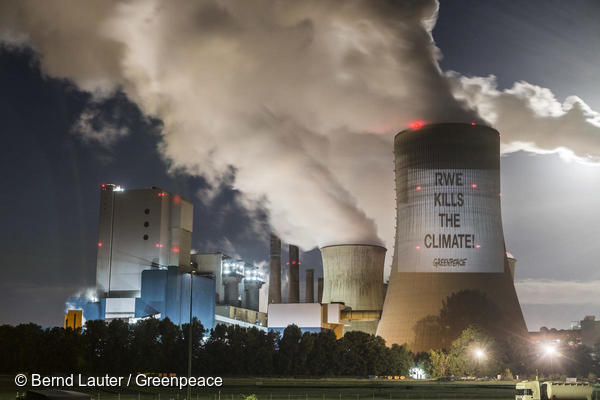This case study was written Greig Aitken (BankTrack) and Kuba Gogolewski (Foundation Development YES – Open-Pit Mines NO) for our latest bank report card, Banking on Climate Change: Fossil Fuel Finance Report Card 2019.
Europe’s rapidly advancing clean energy transition saw another important milestone in 2018 as renewable energy — solar, wind, biomass, and hydropower — overtook coal as Germany’s biggest source of electricity for the first time. For now, though, coal remains Germany’s single largest source of power, accounting for 39 percent of electricity generation last year in Europe’s largest economy.1
Yet Germany’s most significant coal event of 2018 was headline-grabbing public opposition aimed at plans by RWE, one of the country’s biggest utilities, to destroy more of the 12,000-year-old Hambach Forest in order to expand its nearby open-pit lignite coal mine.2 This totemic case illustrates not only that coal’s days are numbered in Germany but also the serious risks now facing RWE and the banks that continue to finance Europe’s biggest CO2 emitter.3

Following months of a stand-off during which RWE brazenly mobilized its machinery alongside 4,000 police deployed to clear protestor tree houses, in October a court order forced the company to suspend clearance activities at the forest. This standstill continues as German courts consider a lawsuit brought by the environmental organization Bund für Umwelt und Naturschutz Deutschland (BUND) to oppose the forest’s clearance.4
RWE executives have sought to justify further flattening of the forest by claiming, among other things, that the company would stand to lose $5.9 billion if it is stopped in its tracks.5 However, according to Claudia Kemfert, a professor of energy economics at the research institute Deutsches Institut für Wirtschaftsforschung, or DIW Berlin, “RWE misread the mood of the public by moving ahead to dig up the forest. Hambach is a symbol of the watershed we’ve reached in this country. The country knows it.”6
It also has been a watershed moment for some of RWE’s investors. Germany’s DekaBank went on the public record urging RWE to suspend its clearing work, arguing that “as shareholders, we have no benefit from an escalation. On the contrary, we see the risk that RWE will unnecessarily jeopardise its reputation and future viability.”7 The Storebrand pension fund, Norway’s largest private asset manager, which had already dropped its RWE shares in 2017 because of the utility’s coal dependence, also publicly called on investors to sell their shares in RWE because of the Hambach debacle.8
No such noises or divestments have yet emanated from the major banks propping up RWE’s coal expansion activities. The banks listed below and other RWE financial backers are now on watch to disassociate themselves from a company that is clinging to its coal business at all costs. Long-awaited proposals from Germany’s coal commission in January included a pronouncement that protection of the Hambach Forest is “desirable.”9 In reaction, claiming this would cost tens of millions of euros, the CEO of RWE commented: “One would have to ask oneself how much is a tree worth.”10
Refusing still to remove its threat to the Hambach Forest, RWE’s reckless coal mine expansion plans place it firmly on the wrong side of history and squarely against public opinion.
| RWE’s biggest coal mining bankers over the last three years are:11
1. Deutsche Bank |
- William Wilkes and Brian Parkin, “Renewables Beat Coal in Germany Power Mix for First Time,” Bloomberg, 4 January 2019.
- William Wilkes and Brian Parkin, “A Coal Mine Is Devouring a 12,000-Year-Old Forest,” Bloomberg, 3 December 2018.
- “Last Gasp: The Coal Companies Making Europe Sick,” Europe Beyond Coal, 20 November 2018.
- Reuters, “German Court Orders Suspension of Hambach Forest Clearance,” Deutsche Welle, 5 October 2018.
- Christoph Steitz, “Mining Halt at Germany’s Hambach Forest Would Cost RWE up to $5.9 Billion: ZDF,” Reuters, 20 September 2018.
- William Wilkes and Brian Parkin, “A Coal Mine Is Devouring a 12,000-Year-Old Forest,” Bloomberg, 3 December 2018.
- @DekaBank, “Deka-Experte Mathes: „Angesichts der zugespitzten Situation im #HambacherForst …,” Twitter, 14 September 2018.
- Jan Erik Saugestad, “RWE Shares Are Risky — We Have Dropped Them,” Storebrand, 26 October 2018..
- Andreas Rinke, “Germany’s Merkel Signals Support for 2038 Coal Exit Deadline,” Reuters, 5 February 2019.
- Tom Kaeckenhoff, “Germany’s RWE Could Preserve Hambach Forest, but at a Price,” Reuters, 4 February 2019.
- Bloomberg Finance L.P. and the data researched for this report, January 2019. This subset of the coal mining financing data aggregates bank financing for these four companies, adjusted down by the proportion of coal mining in the activities of each company named on a given transaction.
